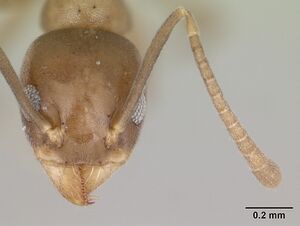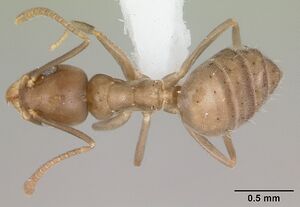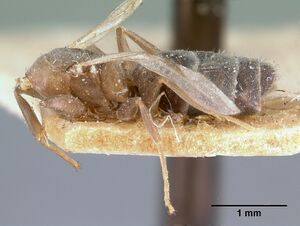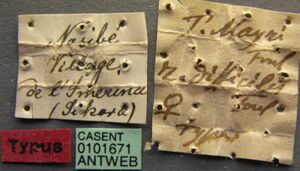Technomyrmex difficilis
| Technomyrmex difficilis | |
|---|---|

| |
| Scientific classification | |
| Kingdom: | Animalia |
| Phylum: | Arthropoda |
| Class: | Insecta |
| Order: | Hymenoptera |
| Family: | Formicidae |
| Subfamily: | Dolichoderinae |
| Genus: | Technomyrmex |
| Species: | T. difficilis |
| Binomial name | |
| Technomyrmex difficilis Forel, 1892 | |
| Synonyms | |
| |
Fernández and Guerrero (2008) - A tramp species detected in the New World at the zoo in Washington and outdoors in Florida and Puerto Rico (Bolton 2007 and personal communication). Heterick & Kitching (2022) collected this species in the canopy of a lowland dipterocarp forest in Brunei.
| At a Glance | • Highly invasive • Supercolonies • Ergatoid male |
Photo Gallery
 Technomyrmex difficilis workers foraging on the underside of a leaf. Jardın Botanico Nacional Dr. Rafael Ma. Moscoso, Santo Domingo, Dominican Republic. February 9, 2020. Photo © Carlos de Soto Molinari.
Technomyrmex difficilis workers foraging on the underside of a leaf. Jardın Botanico Nacional Dr. Rafael Ma. Moscoso, Santo Domingo, Dominican Republic. February 9, 2020. Photo © Carlos de Soto Molinari.
Identification
Bolton (2007) - A member of the T. pallipes complex in the Technomyrmex albipes group. Closely related to Technomyrmex albipes but separated by the presence of setae on the dorsum of the head behind the level of the posterior margin of the eye (never developed in albipes) and by having the promesonotum somewhat longer and more slender, DTI 127 – 135 (as opposed to DTI I 10- 124 in albipes). This species has been confused many times with albipes, and isolated specimens with the characteristic cephalic setae abraded away are difficult to identify. In such specimens the eye may give a clue to the correct identity because in general, with the head in full-face view the eye in albipes workers is flatter and less convex than in difficilis so that the outer margin usually just fails to break the outline of the side of the head in the former but distinctly interrupts the outline of the side in the latter. There is some variation of this feature in both species. Additionally, the mesonotum generally has a pair of setae present in difficilis whereas mesonotal setae are generally absent in albipes. Again this character is variable because difficilis samples are known where mesonotal setae are lacking and albipes samples are known in which a pair is present.
Of all the material examined a few specimens from Madagascar and one specimen from U.S.A. had an extra pair of short setae on the dorsum of the head, behind the universally present pair. Whether these are genuine workers or the most worker-like form of intercaste remains to be seen. These individuals may resemble Technomyrmex pallipes in this character but samples of the latter always have the middle and hind femora and tibiae distinctly lighter in colour than the mesosoma and do not have tarsi that are much paler than the tibiae. Malagasy material of difficilis tends to differ slightly from that of the rest of the world. The cuticle of the head and mesosoma is somewhat more glossy, the angle through which the propodeal dorsum meets the declivity is blunter and setae on the first gastral tergite are shorter. These differences seem consistently to isolate the Malagasy population, but at present I am not convinced that they are sufficient to justify separation at species-rank T. difficilis was originally described as a race of Technomyrmex mayri, but the two are quite different. T. difficilis is a smaller species with shorter scapes, relatively larger eyes and a shorter, more compact mesosoma (compare measurements and indices). In addition, the metathoracic spiracles of mayri, m dorsal view, do not abut the metanotal groove, and the propodeal dorsum is longer, its straight-line length in profile is greater than the have setae that arise above the level of the spiracle whereas such setae are always present in difficilis.
Fernández and Guerrero (2008) - This species is separated from others in the New World by morphological traits such as dorsum of head behind posterior margin of eye with a single pair of setae and tarsus of hind leg distinctly lighter than the tibia.
Keys including this Species
- Key to Afrotropical and west Palaearctic Technomyrmex
- Key to Arabian Technomyrmex
- Key to Australian Technomyrmex Species
- Key to Malagasy Technomyrmex
- Key to New World Technomyrmex species
- Key to Oriental Technomyrmex
- Key to Technomyrmex of Taiwan
- Key to US Technomyrmex species
Distribution
Latitudinal Distribution Pattern
Latitudinal Range: 22.08° to -19.006727°.
| North Temperate |
North Subtropical |
Tropical | South Subtropical |
South Temperate |
- Source: AntMaps
Distribution based on Regional Taxon Lists
Afrotropical Region: South Africa.
Australasian Region: Australia.
Indo-Australian Region: Borneo, Brunei Darussalam, Hawaii, Indonesia, Krakatau Islands, Malaysia, New Guinea, Philippines, Singapore, Timor-Leste.
Malagasy Region: Madagascar (type locality), Seychelles.
Nearctic Region: United States.
Neotropical Region: Antigua and Barbuda, Honduras, Jamaica, Lesser Antilles, Puerto Rico, Saint Kitts and Nevis.
Oriental Region: Laos, Taiwan, Thailand, Vietnam.
Distribution based on AntMaps
Distribution based on AntWeb specimens
Check data from AntWeb
Countries Occupied
| Number of countries occupied by this species based on AntWiki Regional Taxon Lists. In general, fewer countries occupied indicates a narrower range, while more countries indicates a more widespread species. |

|
Estimated Abundance
| Relative abundance based on number of AntMaps records per species (this species within the purple bar). Fewer records (to the left) indicates a less abundant/encountered species while more records (to the right) indicates more abundant/encountered species. |

|
Biology
Bolton (2007) - In his unpublished thesis Warner (2003) succinctly summarises the nature of difficilis (misidentified as albipes in the study) as an invasive in Florida, U.S.A. He says that it “nests at or above ground level in numerous locations within the landscape, home and suburban woodland habitats. Nests are frequently found in trees and bushes, tree holes, under palm fronds and old petiole bases, under leaves on trees, in loose mulch, under debris, in leaf-litter, both on the ground and in rain gutters, wall voids, and attics. Nests tend to be found outside of structures more than inside.” He points out that its main foods are plant nectar and honeydew but that the ants will also feed on dead insects and other protein. In houses they forage most commonly in kitchens and bathrooms, the best sources of food and water, as well as on exterior structures. Like some other species in the group (e.g. Technomyrmex pallipes, Technomyrmex jocosus) they have been found nesting in electrical fixtures. Outdoors, workers of this species are most commonly encountered on vegetation although, like most or maybe all other species in the albipes group, they also nest and forage terrestrially.
Worker-queen intercastes are produced in difficilis, and according to Warner (2003, unpublished thesis) these may make up nearly half the colony. Intercastes have reproductive functions and are not usually found outside of nests; foraging behavior appears to lie strictly in the domain of true workers. As is known in several other species of the albipes group ergatoid males, as well as the usual alates, are produced by difficilis. The alate males mate with alate queens in the usual nuptial flight, which initiates new nests. The queens of these colonies eventually die off and are replaced by reproductive worker-queen intercastes, all grades of which have spermathecae (absent from true workers) and they mate with ergatoid males. Nests in this condition then multiply by fission and produce polydomous colonies that are later able to produce new generations of alate queens and males.
Saudi Arabia Sharaf et al. (2018): The nesting habit of T. difficilis is diverse (Warner 2003). Nests are found in both urban and undisturbed native habitats and are constructed directly into the ground, in trees holes, under palm fronds and old petiole bases, in leaf-litter and under stones and debris. The feeding habits include plant nectar, honeydew, dead insects, and other protein sources. The wide range of nesting sites and feeding habits make T. difficilis one of the most successfully dispersed species of the genus worldwide (Bolton 2007). The single specimen studied here was found hiding inside the persistent stamen cluster of a pomegranate fruit imported from Yemen at “Al Othaim Hypermarket”, Riyadh.
Taiwan Yamane et al. (2018) - In Taiwan only a single worker has been collected (Lanyu [Orchid] Island). Nothing is known about the nesting biology of this species in Taiwan.
Castes
Worker
Images from AntWeb
   
| |
| Worker. Specimen code casent0003318. Photographer April Nobile, uploaded by California Academy of Sciences. | Owned by MCZ, Cambridge, MA, USA. |
   
| |
| Worker. Specimen code casent0106111. Photographer Michael Branstetter, uploaded by California Academy of Sciences. | Owned by UCDC, Davis, CA, USA. |
   
| |
| Worker. Specimen code casent0419034. Photographer April Nobile, uploaded by California Academy of Sciences. | Owned by CAS, San Francisco, CA, USA. |
   
| |
| Worker. Specimen code casent0419194. Photographer April Nobile, uploaded by California Academy of Sciences. | Owned by CAS, San Francisco, CA, USA. |
   
| |
| Syntype of Technomyrmex mayri nitidulans. Worker. Specimen code casent0101079. Photographer April Nobile, uploaded by California Academy of Sciences. | Owned by NHMB, Basel, Switzerland. |
   
| |
| Worker. Specimen code casent0101080. Photographer April Nobile, uploaded by California Academy of Sciences. | Owned by NHMB, Basel, Switzerland. |
   
| |
| Worker. Specimen code casent0003175. Photographer April Nobile, uploaded by California Academy of Sciences. | Owned by CAS, San Francisco, CA, USA. |
   
| |
| Worker. Specimen code casent0101077. Photographer April Nobile, uploaded by California Academy of Sciences. | Owned by NHMB, Basel, Switzerland. |
   
| |
| Worker. Specimen code casent0101823. Photographer April Nobile, uploaded by California Academy of Sciences. | Owned by MHNG, Geneva, Switzerland. |
   
| |
| Syntype of Technomyrmex difficilis. Worker. Specimen code casent0101932. Photographer April Nobile, uploaded by California Academy of Sciences. | Owned by MHNG, Geneva, Switzerland. |
  
| |
| Worker. Specimen code casent0101078. Photographer April Nobile, uploaded by California Academy of Sciences. | Owned by NHMB, Basel, Switzerland. |
  
| |
| Worker. Specimen code casent0101791. Photographer April Nobile, uploaded by California Academy of Sciences. | Owned by MHNG, Geneva, Switzerland. |
Queen
Images from AntWeb
   
| |
| Queen (alate/dealate). Specimen code casent0104538. Photographer April Nobile, uploaded by California Academy of Sciences. | Owned by ABS, Lake Placid, FL, USA. |
  
| |
| Specimen code casent0101671. . | |
Male
Images from AntWeb
    
| |
| Male (alate). Specimen code casent0102735. Photographer April Nobile, uploaded by California Academy of Sciences. | Owned by ABS, Lake Placid, FL, USA. |
    
| |
| Male (alate). Specimen code casent0049968. Photographer April Nobile, uploaded by California Academy of Sciences. | Owned by CAS, San Francisco, CA, USA. |
Nomenclature
The following information is derived from Barry Bolton's Online Catalogue of the Ants of the World.
- difficilis. Technomyrmex mayri r. difficilis Forel, 1892l: 242 (w.q.) MADAGASCAR. Raised to species and senior synonym of nitidulans: Bolton, 2007a: 47.
- nitidulans. Technomyrmex mayri st. nitidulans Santschi, 1930a: 72, figs. 31-33 (w.) MADAGASCAR. Junior synonym of difficilis: Bolton, 2007a: 47.
Unless otherwise noted the text for the remainder of this section is reported from the publication that includes the original description.
Description
Worker
Bolton (2007) - TL 2.4 - 3.1, HL 0.57 - 0.76, HW 0.52 - 0.69, SL 0.52 - 0.74, PW 0.36 - 0.47, WL 0.74 -1.02 (35 measured). Indices: CI 89 - 97, SI 95 - 107, OI 25 - 30, EPI 72 - 86, DTI 127 - 135.
Frontal carina with 2 (very rarely 3) setae: in profile the first above the torulus, the second at about the level of the antenor margin of the eve; when a third seta present it is between these two. Dorsum of head posterior to this with a single pair of setae, in profile located just over half way between level of posterior margin of eye and posterior margin of head, not at the posterior margin; this pair of setae distinctly shorter than the posteriormost seta on the frontal carina (see notes below). Anterior clypeal margin with a very weak, shallow median indentation. With head in full-face view the sides shallowly convex and the posterior margin with a small shallow indentation medially. Eyes located in front of midlength, EPI < 90; outer margin of eye breaks the outline of the side. Number of setal pairs on mesosoma: pronotum 1 - 2; mesonotum 0 – 1 (usually 1); propodeal dorsum 0; lateral margins of propodeal declivity 1 - 2, above the level of the spiracle. With mesosoma in profile the mesonotal outline is evenly curved, without a distinct step or angle in the outline that defines conspicuous dorsal and declivitous faces. Dorsum of propodeum short in profile and meeting the declivity in an angle; length of dorsum less than depth of declivity to spiracle. In dorsal view the metathoracic spiracles are very close to, or abut, the metanotal groove. Gastral tergites 1 - 4 each with numerous setae, distributed everywhere on the sclerites; maximum length of setae on first gastral tergite is usually slightly less than the maximum diameter of the eye but sometimes the two are subequal. Head, mesosoma, petiole and gaster dark brown to black; in profile the gaster may be slightly lighter than the mesosoma. Coxae, femora and tibiae the same colour as the mesosoma or slightly lighter; never with strongly contrasting lighter coxae. Tarsi of middle and hind legs yellowish white to yellow, distinctly paler than the tibiae.
Type Material
Bolton (2007) - Syntype workers and queen, Madagascar: Noslbe, Village de l'Imerina (Sikora) (Musee d'Histoire Naturelle Genève) [examined].
- Technomyrmex mayri difficulis Forel, 1892: Syntype, workers, queen, Village de l'Imerina, Nosibe, Madagascar, Musee d'Histoire Naturelle Genève.
Determination Clarifications
Bolton (2007) - In recent synoptic works on the Australian ant fauna that mention albipes, that of Shattuck (1999) is most probably difficilis, and the unnamed species of Andersen (2000) is certainly difficilis as his figure 29 has the right proportions and clearly shows the posteriorly placed pair of setae on the head. T. difflcilis has also successfully colonised the state of Florida, U.S.A., where it was first described, as albipes, by Deyrup (1991) and later included under that name by Vail, Davis, et al. (1994) and Deyrup, bavis & Cover (2000). It also seems probable that a proportion of the material listed as albipes by Wilson & Taylor (1967) will be difficilis.
References
- Bolton, B. 2007. Taxonomy of the dolichoderine ant genus Technomyrmex Mayr (Hymenoptera: Formicidae) based on the worker caste. Contributions of the American Entomological Institute. 35(1):1-149.
- Cantone S. 2018. Winged Ants, The queen. Dichotomous key to genera of winged female ants in the World. The Wings of Ants: morphological and systematic relationships (self-published).
- Fernández, F. and R. J. Guerrero. 2008. Technomyrmex (Formicidae: Dolichoderinae) in the New World: synopsis and description of a new species. Revista Colombiana de Entomología. 34:110-115.
- Forel, A. 1892o. Les Formicides. [concl.]. In: Grandidier, A. Histoire physique, naturelle, et politique de Madagascar. Volume XX. Histoire naturelle des Hyménoptères. Deuxième partie. Supplèment au 28e fascicule. Paris: Hachette et Cie, pp. 229-280.
- Heterick, B.E., Kitching, R.L. 2022. The ants (Hymenoptera: Formicidae) of a one-hectare plot of lowland dipterocarp forest. Entomologist’s Monthly Magazine 158(4), 261–272 (doi:10.31184/m00138908.1584.4153).
- Khachonpisitsak, S., Yamane, S., Sriwichai, P., Jaitrong, W. 2020. An updated checklist of the ants of Thailand (Hymenoptera, Formicidae). ZooKeys 998, 1–182 (doi:10.3897/zookeys.998.54902).
- Pech, P., Bezděk, A. 2016. Ergatomorph wingless males in Technomyrmex vitiensis Mann, 1921 (Hymenoptera: Formicidae). Journal of Hymenoptera Research 53, 25–34 (doi:10.3897/jhr.53.8904).
- Sharaf, M.R., Al Dhafer, H.M., Aldawood, A.S. 2018. Review of the ant genus Technomyrmex Mayr, 1872 in the Arabian Peninsula (Hymenoptera, Formicidae). ZooKeys 780: 35–59 (DOI10.3897/zookeys.780.26272).
- Terayama, M., Sunamura, E., Fujimaki, R., Ono, T., Eguchi, K. 2021. A Surprisingly Non-attractiveness of Commercial Poison Baits to Newly Established Population of White-Footed Ant, Technomyrmex brunneus (Hymenoptera: Formicidae), in a Remote Island of Japan. Sociobiology 68, 5898 (doi:10.13102/sociobiology.v68i1.5898).
- Wang, W.Y., Soh, E.J.Y., Yong, G.W.J., Wong, M.K.L., Benoit Guénard, Economo, E.P., Yamane, S. 2022. Remarkable diversity in a little red dot: a comprehensive checklist of known ant species in Singapore (Hymenoptera: Formicidae) with notes on ecology and taxonomy. Asian Myrmecology 15: e015006 (doi:10.20362/am.015006).
- Wetterer, J. K. 2013c. Worldwide spread of the difficult white-footed ant, Technomyrmex difficilis (Hymenoptera: Formicidae). Myrmecological News 18:93-97.
- Yamane, S., Leong, C.-M., Lin, C.C. 2018. Taiwanese species of the ant genus Technomyrmex (Formicidae: Dolichoderinae). Zootaxa 4410: 35–56 (DOI 10.11646/zootaxa.4410.1.2).
- Yamane, S., Tanaka, H.O., Hasimoto, Y., Ohashi, M., Meleng, P., Itioka, T. 2021. A list of ants from Lambir Hills National Park and its vicinity, with their biological information: Part II. Subfamilies Leptanillinae, Proceratiinae, Amblyoponinae, Ponerinae, Dorylinae, Dolichoderinae, Ectatomminae and Formicinae. Contributions from the Biological Laboratory, Kyoto University 31, 87–157.
References based on Global Ant Biodiversity Informatics
- Baroni Urbani C. 1977. Katalog der Typen von Formicidae (Hymenoptera) der Sammlung des Naturhistorischen Museums Basel (2. Teil). Mitt. Entomol. Ges. Basel (n.s.) 27: 61-102.
- Bolton B. 2007. Taxonomy of the dolichoderine ant genus Technomyrmex Mayr (Hymenoptera: Formicidae) based on the worker caste. Contributions of the American Entomological Institute 35(1): 1-150.
- Dorow, Wolfgang H. O. 1995. Review and Bibliography of the ants of the Seychelles (Hymenoptera: Formicidae). J. Afr. Zool. 110:73-96
- Emery C. 1913. Hymenoptera. Fam. Formicidae. Subfam. Dolichoderinae. Genera Insectorum 137: 1-50.
- Fisher B. L. 1997. Biogeography and ecology of the ant fauna of Madagascar (Hymenoptera: Formicidae). Journal of Natural History 31: 269-302.
- Fisher B. L. 2003. Formicidae, ants. Pp. 811-819 in: Goodman, S. M.; Benstead, J. P. (eds.) 2003. The natural history of Madagascar. Chicago: University of Chicago Press, xxi + 1709 pp.
- Forel A. 1909. Fourmis du Musée de Bruxelles. Fourmis de Benguela récoltées par M. Creighton Wellman, et fourmis du Congo récoltées par MM. Luja, Kohl et Laurent. Annales de la Société Entomologique de Belgique 53: 51-73.
- Ravelomanana A., and B. L. Fisher. 2013. Diversity of ants in burned and unburned grassland , and dry deciduous forest in the Beanka Reserve, Melaky Region, western Madagascar. Malagasy Nature 7: 171-183.
- Santschi F. 1930. Description de Formicides éthiopiens nouveaux ou peu connus. V. Bulletin et Annales de la Société Entomologique de Belgique 70: 49-77.
- Shattuck S. O. 1994. Taxonomic catalog of the ant subfamilies Aneuretinae and Dolichoderinae (Hymenoptera: Formicidae). University of California Publications in Entomology 112: i-xix, 1-241.
- Wetterer J. K. 2013. Worldwide spread of the difficult white-footed ant, Technomyrmex difficilis (Hymenoptera: Formicidae). Myrmecological News 18: 93-97.
- Wheeler W. M. 1922. Ants of the American Museum Congo expedition. A contribution to the myrmecology of Africa. IX. A synonymic list of the ants of the Malagasy region. Bulletin of the American Museum of Natural History 45: 1005-1055

